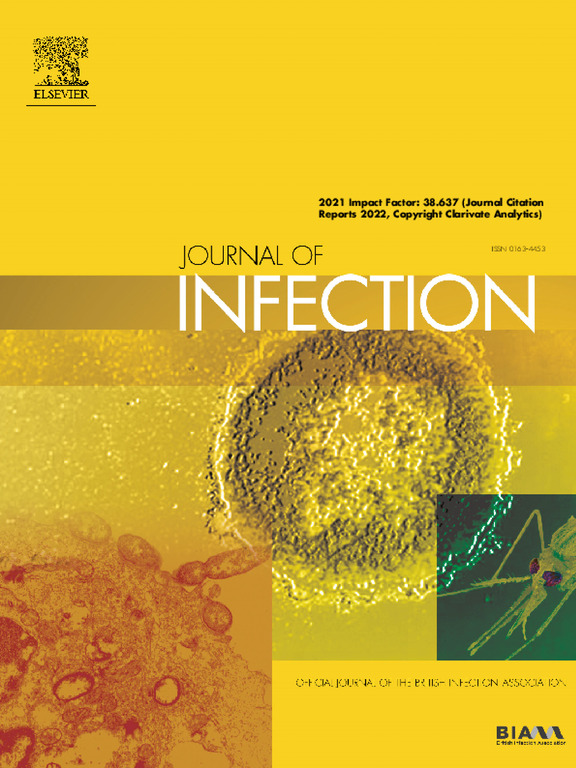孕期和产后感染侵袭性肺炎球菌疾病的风险以及与孕产妇和胎儿不良结局的关联:前瞻性队列研究,英格兰,2014-19 年。
IF 14.3
1区 医学
Q1 INFECTIOUS DISEASES
引用次数: 0
摘要
背景:肺炎球菌感染与严重的发病率和死亡率有关,尤其是在极端年龄段和患有基础疾病的人群中。人们对孕期或产后侵袭性肺炎球菌疾病(IPD)的风险、表现或结果知之甚少:英国卫生安全局对英格兰的 IPD 进行了强化的全国性监测。我们利用全国监测数据计算了英格兰五年内妊娠期、产后和非妊娠期育龄妇女感染 IPD 的风险和结果:2014年7月1日至2019年6月30日期间,15-44岁女性中共有1701例IPD病例,其中包括123例(7.2%)孕妇、38例(2.1%)产后妇女和1540例(90.7%)非孕妇。孕妇的 IPD 发病率(0.048/1,000 女性-年)与非孕妇(0.041/1,000 女性-年;发病率比 [IRR]:1.17; 95%CI 0.96-1.40; p=0.11)。然而,如果按孕期进行分层,怀孕三个月的妇女的发病率要高出 2.27 倍(95%CI 1.79-2.85,p解释):与非孕妇相比,孕妇患 IPD 的风险总体上似乎并没有增加,但怀孕三个月时感染 IPD 的孕妇的发病率似乎增加了三倍多。大多数孕妇和产后妇女都生下了活产婴儿,新生儿随后感染的情况很少见,仅占活产婴儿的 2%。本文章由计算机程序翻译,如有差异,请以英文原文为准。
Risk of invasive pneumococcal disease during pregnancy and postpartum and association with adverse maternal and foetal outcomes: A prospective cohort study, England, 2014-19
Background
Pneumococcal infections are associated with significant morbidity and mortality, especially at the extremes of age and in those with underlying conditions. Little is known about the risks, presentations or outcomes of invasive pneumococcal disease (IPD) during pregnancy or the postpartum period.
Methods
The UK Health Security Agency conducts enhanced national surveillance of IPD in England. We used national surveillance data to calculate IPD risk and outcomes in pregnant, postpartum and non-pregnant women of childbearing age with IPD over a five-year period in England.
Findings
There were 1701 IPD cases in women aged 15–44 years between 1 July 2014 and 30 June 2019, including 123 (7.2%) pregnant, 38 (2.2%) postpartum and 1540 (90.5%) non-pregnant women. IPD incidence in pregnant women (0.048/1000 woman-years) was not significantly different compared to non-pregnant women (0.041/1000 woman-years; Incidence Rate Ratio [IRR]: 1.17; 95%CI 0.96–1.40; p=0.11). When stratified by trimester, however, women in their third trimester had a 2.27-fold (95%CI 1.80–2.85, p<0.001) increased risk of IPD, compared to non-pregnant women (IRR 2.27, 95%CI 1.78–2.85, p<0.001), while those in the first (IRR 0.49, 95%CI 0.28–0.80) and second trimester (IRR 0.71, 95%CI 0.47–1.04) had a lower risk, albeit only statistically significant for the first trimester. Postpartum women (0.144 per 1000 woman-years), on the other hand, had a 3.49-fold (95%CI 2.46–4.81, p<0.001) higher IPD risk than non-pregnant women.
Most pregnant women developed IPD during their third trimester (80/123, 65.0%), with all but one pregnancy resulting in a live birth. IPD in the second trimester was associated with live birth in 77.8% of cases (21/27), while 22.2% experienced a miscarriage (5/27, 18.5%) or stillbirth (1/27, 3.7%). IPD in the first trimester was associated with live birth in 41.7% of cases (5/12), miscarriages in 41.7% (5/12), and termination in 16.7% (2/12) cases. Only three neonates (3/142) had confirmed IPD. There were no deaths in pregnant women with IPD compared to 5.5% (85/1540) in non-pregnant women.
Interpretation
While pregnant women overall did not appear to have an increased risk of IPD compared to non-pregnant women, those infected in third trimester or postpartum appeared to have more than twice the incidence. Most pregnant and postpartum women had a live birth, and subsequent neonatal infection was rare, occurring in 2% of live births.
求助全文
通过发布文献求助,成功后即可免费获取论文全文。
去求助
来源期刊

Journal of Infection
医学-传染病学
CiteScore
45.90
自引率
3.20%
发文量
475
审稿时长
16 days
期刊介绍:
The Journal of Infection publishes original papers on all aspects of infection - clinical, microbiological and epidemiological. The Journal seeks to bring together knowledge from all specialties involved in infection research and clinical practice, and present the best work in the ever-changing field of infection.
Each issue brings you Editorials that describe current or controversial topics of interest, high quality Reviews to keep you in touch with the latest developments in specific fields of interest, an Epidemiology section reporting studies in the hospital and the general community, and a lively correspondence section.
 求助内容:
求助内容: 应助结果提醒方式:
应助结果提醒方式:


